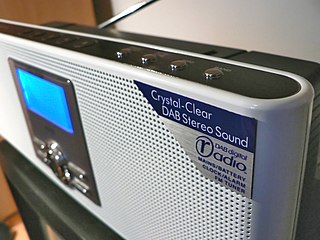A subcarrier is a sideband of a radio frequency carrier wave, which is modulated to send additional information. Examples include the provision of colour in a black and white television system or the provision of stereo in a monophonic radio broadcast. There is no physical difference between a carrier and a subcarrier; the "sub" implies that it has been derived from a carrier, which has been amplitude modulated by a steady signal and has a constant frequency relation to it.

Digital radio is the use of digital technology to transmit or receive across the radio spectrum. Digital transmission by radio waves includes digital broadcasting, and especially digital audio radio services.
Near Instantaneous Companded Audio Multiplex (NICAM) is an early form of lossy compression for digital audio. It was originally developed in the early 1970s for point-to-point links within broadcasting networks. In the 1980s, broadcasters began to use NICAM compression for transmissions of stereo TV sound to the public.

ARD is a joint organisation of Germany's regional public-service broadcasters. It was founded in 1950 in West Germany to represent the common interests of the new, decentralised, post-war broadcasting services – in particular the introduction of a joint television network.
Das Erste is the flagship national television channel of the ARD association of public broadcasting corporations in Germany. Das Erste is jointly operated by the nine regional public broadcasting corporations that are members of the ARD.
Westdeutscher Rundfunk Köln, shortened to WDR, is a German public-broadcasting institution based in the Federal State of North Rhine-Westphalia with its main office in Cologne. WDR is a constituent member of the consortium of German public-broadcasting institutions, ARD. As well as contributing to the output of the national television channel Das Erste, WDR produces the regional television service WDR Fernsehen and six regional radio networks.
Südwestrundfunk, shortened to SWR, is a regional public broadcasting corporation serving the southwest of Germany, specifically the federal states of Baden-Württemberg and Rhineland-Palatinate. The corporation has main offices in three cities: Stuttgart, Baden-Baden and Mainz, with the director's office being in Stuttgart. It is a part of the ARD consortium.
Sputnik or MDR Sputnik is a youth-oriented German radio station, and is part of Leipzig-based public broadcaster Mitteldeutscher Rundfunk (MDR), based in Halle. The station, which primarily broadcasts pop and rock music, is the successor to the East German youth station DT64, founded in 1964 on the occasion of the Deutschlandtreffen der Jugend. It was given its present name on 1 May 1993, following German reunification in 1990; the new name, inspired by the Soviet Sputnik satellite, was the suggestion of the then Minister-President of Saxony, Kurt Biedenkopf.

Tatort is a German-language police procedural television series that has been running continuously since 1970 with 30 feature-length episodes per year, making it the longest-running German TV drama. Developed by the German public-service broadcasting organization ARD for their channel Das Erste, it is unique in its approach in that it is jointly produced by all of the organization's regional members as well as its partnering Austrian and Swiss national public-service broadcasters, whereby every regional station contributes several episodes to a common pool.
Television in Germany began in Berlin on 22 March 1935, broadcasting for 90 minutes three times a week. It was home to the first regular television service in the world, named Fernsehsender Paul Nipkow.

Norddeutscher Rundfunk, commonly shortened to NDR, is a public radio and television broadcaster, based in Hamburg. In addition to the city-state of Hamburg, NDR broadcasts for the German states of Lower Saxony, Mecklenburg-Vorpommern and Schleswig-Holstein. NDR is a member of the ARD organisation.
Sender Freies Berlin was the ARD public radio and television service for Berlin from 1 June 1954 until 30 April 2003. On 1 January 1992, SFB became the public broadcaster for the whole of reunited Berlin. However, SFB had long had a significant audience in East Berlin for some time before German reunification. On 1 May 2003 it merged with Ostdeutscher Rundfunk Brandenburg to form Rundfunk Berlin-Brandenburg.

hr1 is the first radio station of the Hessischer Rundfunk.

The Hörspielpreis der Kriegsblinden, also known as the Kriegsblindenpreis is the most important literary prize granted to playwrights of audio plays written in the German language. The award was established in 1950 by the Bund der Kriegsblinden Deutschlands e.V. (BKD), a German organization for soldiers and civilians blinded during war, whether from working with munitions or explosives or from a bomb attack or while in flight from an attack.
The Axel-Springer-Preis is an annually awarded prize. The Award is given to young journalists in the categories print, TV, radio, and online journalism due to the decisions of the Axel-Springer-Akademie.
RBB Berlin was the third television channel for Berlin, Germany from October 1992 until March 2004. Until May 2003 it was owned by Sender Freies Berlin (SFB), then by its successor, Rundfunk Berlin-Brandenburg (RBB), under the provisional name RBB Berlin. On 1 March 2004, the two previous regional television channels RBB Berlin and RBB Brandenburg were replaced by the new rbb Fernsehen.






